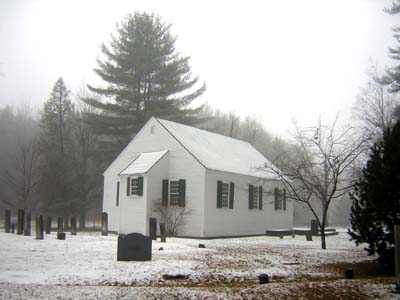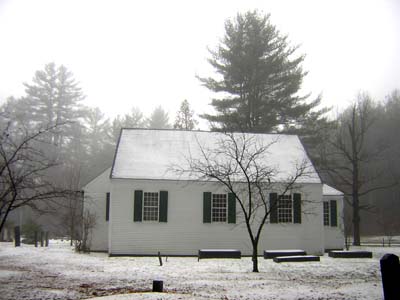| ← back |
Colonial Meetinghouses Featured in this Project |
next → |
 Name of Meetinghouse: Trinity Church, Holderness
Name of Meetinghouse: Trinity Church, Holderness
View on a mapStreet Address of Meetinghouse: 926 NH Route 175 (North Holderness Road), Holderness, NHYear(s) Built: 1797 National Register of Historic Places Designation: yes New Hampshire State Register of Historic Places: ? Organization responsible: Churchyard Cemetery Association Organization's address: n/a Organization's official web site: Churchyard Cemetery Association Town Information: Town of Holderness, New Hampshire Nearby Attraction: Holderness School Tax status: Tax Exempt 501(c)(3) Contact: See web site This page was last updated on: January 24, 2009 Acknowledgements: The following text has been taken in part from Eva A. Spears' 1938 book Colonial Meeting-Houses of New Hampshire, as is the above photograph. Additional material is taken from the Churchyard Cemetery Association web site, www.churchyardcemetery.org, and from personal communication with Barry Borella of the Churchyard Cemetery Association, and has been used by permission.
Holderness was originally granted to a group of proprietors who failed to secure their charter and in 1765, under the friendly auspices of Governor Benning Wentworth, the Judge of the Admiralty Court of his Majesty at Portsmouth, Samuel Livermore, obtained the charter to a tract that now includes the towns of Holderness and Campton.
When the settlers of Holderness selected a site for their Puritan meeting-house, since called "Church Hill" and buried their dead in its adjacent town burial lot, Judge Livermore decreed otherwise. Years went by with no place for public worship in that section of the town. At length, Judge Livermore built the small chapel in 1797 which stands in Trinity church yard. The Judge, his wife, and several of his offspring lie beneath table tombstones almost under the eaves.
Of Livermore's Holderness buildings, only Trinity Church remains. Samuel Livermore was an Episcopalian, and his adopted town of Holderness became one of the four New Hampshire communities which supported Episcopalian churches in the 18th century, probably due largely to his influence. Church services were at first conducted in Livermore's large house, but in 1797, Trinity Church was erected nearby on his land. Although no documents survive to describe the construction, there is general agreement that the Livermores bore most of the cost. Never conveyed to the Episcopalian parish or diocese, Trinity Church remained the property of the Livermore family until 1854, when Samuel's grandson deeded it and the adjoining burying ground to the Churchyard Cemetery. By then the church was little used and it has survived unaltered, appearing today virtually as it did in 1797. |

|

|

|

|
 The "meetinghouse" in Holderness, New Hampshire, is Trinity Episcopal Church.
But, you say, how can that be?
I thought meetinghouses were built by the Puritains,
who had no dealings with the Church of England?
In most cases that is true.
In Holderness, the "standing order" was the Church of England.
So in that case, they built an Anglican church.
In colonial times, people tended to live in communities that were like-minded
in terms of their religious affiliation.
The "meetinghouse" in Holderness, New Hampshire, is Trinity Episcopal Church.
But, you say, how can that be?
I thought meetinghouses were built by the Puritains,
who had no dealings with the Church of England?
In most cases that is true.
In Holderness, the "standing order" was the Church of England.
So in that case, they built an Anglican church.
In colonial times, people tended to live in communities that were like-minded
in terms of their religious affiliation.
 Being a far sighted prophet, the Judge realized the trend of revolt in the Colony and in 1774
he retired to this sylvan retreat where he busily developed his saw and grist mills
and became the influential overlord of the region.
He had already married the daughter of Rev. Arthur Browne,
rector of Queen's Chapel, Portsmouth, a lady of poised manner who was capable of curbing her irascible husband.
In 1769, Judge Livermore was appointed the king's Attorney General.
Being a far sighted prophet, the Judge realized the trend of revolt in the Colony and in 1774
he retired to this sylvan retreat where he busily developed his saw and grist mills
and became the influential overlord of the region.
He had already married the daughter of Rev. Arthur Browne,
rector of Queen's Chapel, Portsmouth, a lady of poised manner who was capable of curbing her irascible husband.
In 1769, Judge Livermore was appointed the king's Attorney General.
 With few changes in its interior, this small chapel remains intact with its slip pews in the center,
while square pews line the walls.
The pulpit of pine is as high as the ceiling permits.
Its design is Puritan rather than wine-glass like those usually found in Anglican chancels.
The Judge erected a mansion house which after his demise became the dormitory of Holderness School,
and in later years was burned.
With few changes in its interior, this small chapel remains intact with its slip pews in the center,
while square pews line the walls.
The pulpit of pine is as high as the ceiling permits.
Its design is Puritan rather than wine-glass like those usually found in Anglican chancels.
The Judge erected a mansion house which after his demise became the dormitory of Holderness School,
and in later years was burned.